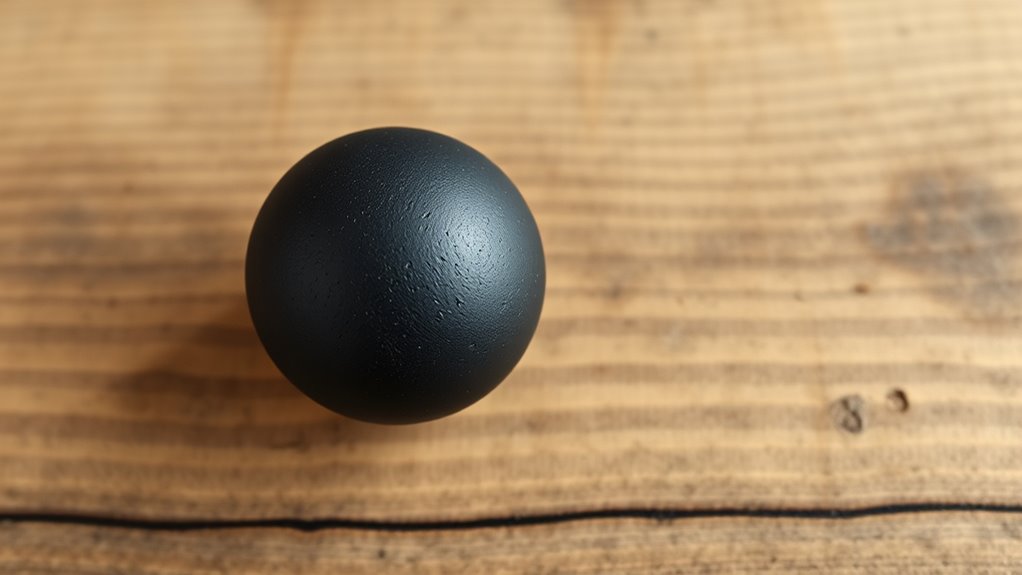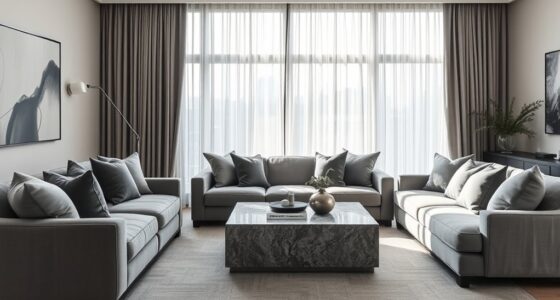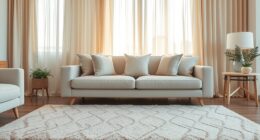In minimalist design, adding texture isn’t about clutter but creating depth and warmth with fewer elements. You can achieve this by choosing tactile materials like natural stone, wood, or woven textiles that invite touch and add character. Combining smooth and rough finishes or layering soft fabrics can make your space feel inviting without overwhelming it. If you want to discover more ways to make your minimalist space rich in tactile interest, keep exploring how texture transforms simplicity into warmth.
Key Takeaways
- Incorporate natural materials like wood, stone, and woven fibers to add tactile warmth within minimalist spaces.
- Use contrasting finishes, such as matte walls with glossy fixtures, to create surface diversity without clutter.
- Layer textured textiles like throws, cushions, and rugs to add depth and tactile interest subtly.
- Introduce textured wall finishes or art to enhance visual and sensory engagement while maintaining simplicity.
- Balance tactile elements with clean lines to create inviting, multi-sensory environments that feel both minimal and rich.
The Role of Texture in Minimalist Design
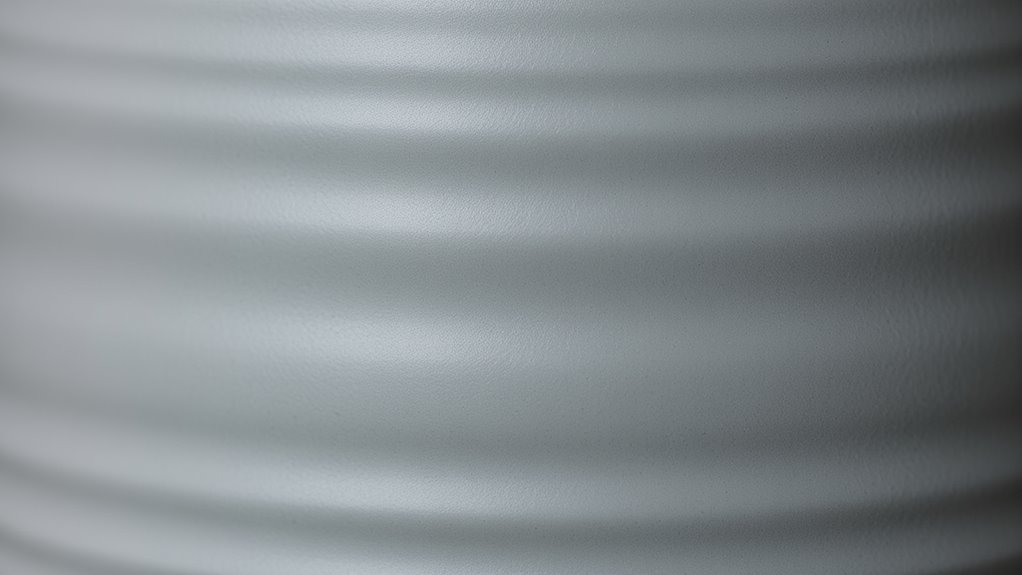
Have you ever wondered how minimalism maintains its clean, simple look without feeling flat or cold? The secret lies in texture contrast. By layering different textures, you create visual interest and depth that keep the space engaging. Think smooth surfaces paired with rough or woven elements—these variations stimulate your senses and prevent the design from feeling sterile. Texture adds warmth and character, inviting touch and exploration without clutter. Sensory engagement becomes a key part of minimalist living, making your space feel welcoming and dynamic. You don’t need busy patterns or excess decor; instead, focus on selecting textures that complement one another. This balance ensures your minimalist space remains refined yet rich in tactile appeal, elevating the overall aesthetic. Additionally, choosing dog breeds with unique coat textures can inspire diverse tactile experiences within your home.
Selecting Tactile Materials for a Minimalist Space

When choosing tactile materials for your minimalist space, consider natural textured options like wood or stone to add subtle interest. Creating contrast with different finishes, such as matte and glossy surfaces, enhances visual depth without clutter. Prioritize warmth and comfort by selecting soft fabrics and cozy textures that invite touch and make the space feel inviting. Incorporating self watering plant pots made from various materials can also add both texture and functionality to your decor.
Natural Textured Materials
In a minimalist space, selecting natural textured materials adds warmth and depth without cluttering the design. Natural stone brings an earthy, tactile quality to surfaces like countertops or accent walls, grounding the space with organic beauty. Woven textiles, such as linen or jute, introduce subtle texture through soft, tactile fabrics that invite touch. Imagine these materials in your environment:
| Material | Visual & Tactile Impression |
|---|---|
| Natural stone | Rough yet polished surface, cool to the touch |
| Woven textiles | Soft, fibrous texture, slightly uneven surface |
| Wooden elements | Warm grain, tactile variation in smoothness |
| Rattan or wicker | Light, airy feel with intricate, tactile weaving |
These materials balance simplicity with natural richness, elevating your minimalist space with tactile authenticity.
A well-chosen textured material can enhance the sensory experience and create a more inviting environment.
Contrast in Finishes
Contrast in finishes creates visual and tactile interest within a minimalist space by combining different textures and sheens. This approach enhances surface diversity and promotes textural harmony, preventing your environment from feeling flat or sterile. By pairing matte walls with polished wood or glossy fixtures, you create subtle yet compelling contrasts that invite touch and exploration. This interplay of finishes energizes the space without overwhelming it, maintaining a calm, cohesive aesthetic. When selecting materials, focus on balancing smooth and rough surfaces, shiny and muted finishes, to craft a layered, engaging environment. Your goal is to evoke emotion through surface diversity, making every element feel intentional and thoughtfully curated. Incorporating surface diversity encourages a richer sensory experience, adding depth to minimalist design.
- Experience the tactile thrill of contrasting textures that invite curiosity.
- Feel the harmony of different sheens working in unison.
- See how surface diversity elevates minimalist simplicity.
Warmth and Comfort
To create a minimalist space that feels warm and inviting, selecting tactile materials plays a crucial role. Cozy textiles like chunky knits, plush throws, and soft rugs add comfort without clutter. Tactile wall finishes, such as textured plaster or fabric-covered panels, introduce warmth and subtle variation. These elements transform cold, stark environments into cozy retreats. Focus on natural materials and muted tones to enhance tactile appeal while maintaining simplicity. Keep your choices intentional, balancing texture with clean lines. Use the table below to explore options that bring warmth and tactile richness to your minimalist space:
| Material Type | Example | Effect |
|---|---|---|
| Cozy textiles | Wool blankets | Inviting, soft touch |
| Tactile wall finishes | Textured plaster | Visual warmth, depth |
| Rugs | Jute or sheepskin | Comfort underfoot |
| Upholstery | Linen or velvet | Adds tactile softness |
Additionally, incorporating natural materials can further enhance the tactile experience while aligning with minimalist aesthetics.
Balancing Texture and Simplicity
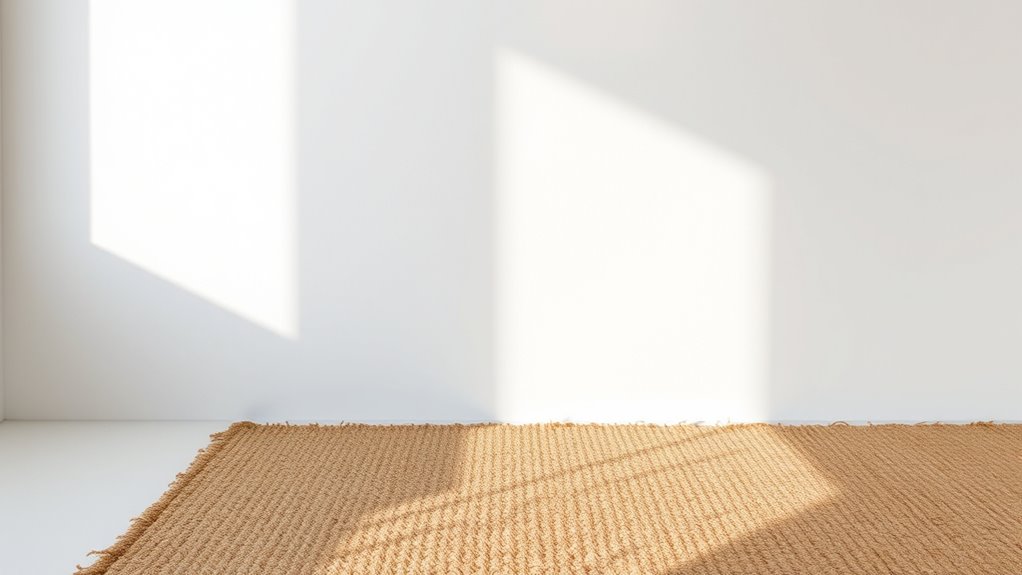
You can create visual and textural balance by carefully choosing materials that contrast without overwhelming. Using tactile contrast techniques helps highlight textures while maintaining simplicity. By thoughtfully combining minimalist material choices with contrast, you achieve a harmonious and inviting space. Incorporating high-quality materials enhances the tactile experience and elevates the overall aesthetic.
Tactile Contrast Techniques
Balancing texture and simplicity in minimalist design requires careful application of tactile contrast techniques. You want to create textural harmony that invites touch without overwhelming the space. Use contrasting textures to highlight key elements, making tactile storytelling possible. For instance, pair smooth surfaces with rougher ones to evoke warmth and depth. Subtle variations, like matte versus glossy finishes, add interest while maintaining simplicity. The goal is to engage the senses thoughtfully, emphasizing quality over quantity. By skillfully mixing textures, you craft a space that feels both serene and dynamic. Remember, tactile contrast isn’t about complexity; it’s about highlighting the beauty in simplicity through deliberate texture choices. Incorporating sound healing science principles, such as subtle vibrations, can further enhance the sensory experience of a space.
Minimalist Material Choices
Choosing the right materials is essential when aiming for a minimalist space that feels both simple and rich in texture. To achieve this, focus on material diversity that adds subtle tactile interest without overwhelming the design. Incorporate durable materials like concrete, hardwood, or metal that stand the test of time and maintain their appeal. These choices provide a sturdy foundation and contribute to a clean aesthetic with natural variations in texture. Balance smooth surfaces with textured finishes to create visual depth while keeping the overall look uncluttered. By selecting materials that combine durability with diverse textures, you ensure your space feels thoughtfully curated, inviting touch without cluttering the minimalist ethos. Ultimately, your material choices should reinforce simplicity while adding richness through tactility. Additionally, understanding how attention in creative practice enhances your ability to select and combine textures intentionally can lead to more mindful and effective design decisions.
Visual and Textural Balance
In minimalist design, the interplay between visual simplicity and tactile richness creates a compelling environment. You aim to strike a balance where texture patterns add depth without overwhelming, maintaining a clean aesthetic. Tactile color influences how you perceive the space, inviting touch while preserving clarity. To achieve harmony, consider subtle contrasts that highlight textures without clutter. Incorporate varied textures thoughtfully, ensuring each element complements the overall simplicity. Remember, the goal is to enhance your space’s serenity with tactile interest that feels natural and effortless. By carefully balancing visual and textural elements, you create an environment that’s both soothing and engaging. This harmonious approach invites you to explore textures that evoke emotion while respecting the minimalist foundation. Additionally, understanding how material selection impacts tactile experience can help refine your design choices.
Incorporating Natural Textures for Warmth

Natural textures instantly add warmth to minimalist spaces, making them feel more inviting and comfortable. By incorporating a variety of natural materials—such as wood, stone, and woven fibers—you create textural diversity that enhances visual interest without clutter. These textures also foster sensory engagement, inviting touch and encouraging a more immersive experience. Using raw, organic elements balances the simplicity of minimalist design, making your space feel grounded and authentic. Focus on selecting pieces with natural finishes that showcase their inherent beauty. When integrated thoughtfully, natural textures soften clean lines and stark surfaces, adding depth and warmth. Understanding paint sprayer maintenance and proper cleaning techniques can help preserve the integrity of textured finishes over time. This approach transforms a minimalist room from cold and sterile to welcoming and tactile, emphasizing that less truly can be more through rich, natural elements.
Using Textured Fabrics in Minimalist Interiors
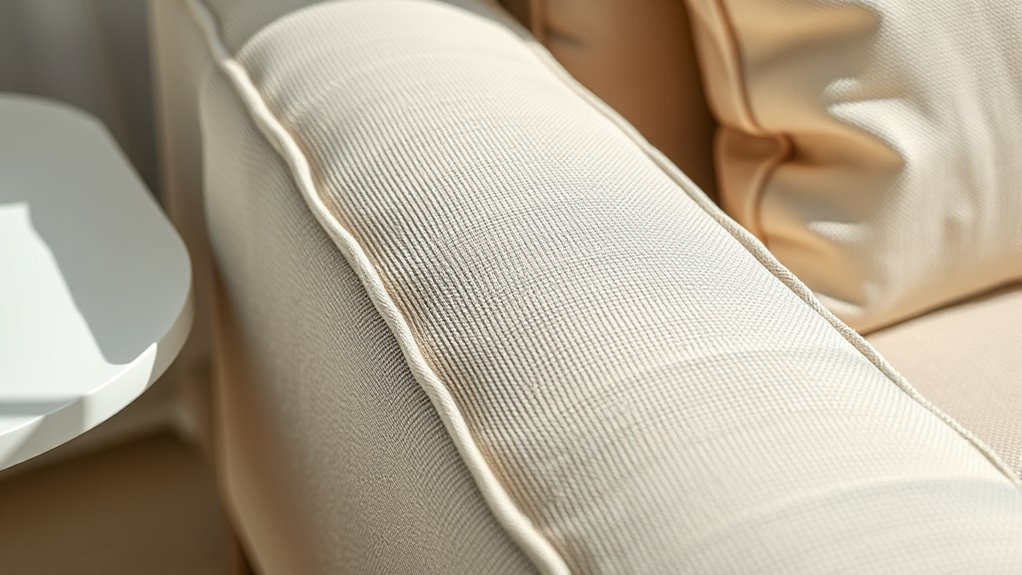
Textured fabrics can transform a minimalist space by adding subtle depth and tactile interest. By choosing tactile materials like linen, boucle, or woven wool, you bring warmth and sensory richness without clutter. These fabrics invite touch, creating a cozy yet uncluttered atmosphere. Incorporate textured fabrics through throw pillows, blankets, or upholstery to subtly elevate your decor. Their tactile qualities evoke emotion and make your space feel inviting. When selecting textured fabrics, consider neutral tones to maintain simplicity or add a pop of muted color for visual interest. The key is to balance texture with clean lines, ensuring it enhances rather than overwhelms. Additionally, exploring support hours for assistance can help you plan the best time to shop for these textiles. With thoughtful use of tactile materials, you create a minimalist environment that’s both serene and engaging.
Creative Ways to Introduce Texture Through Decor
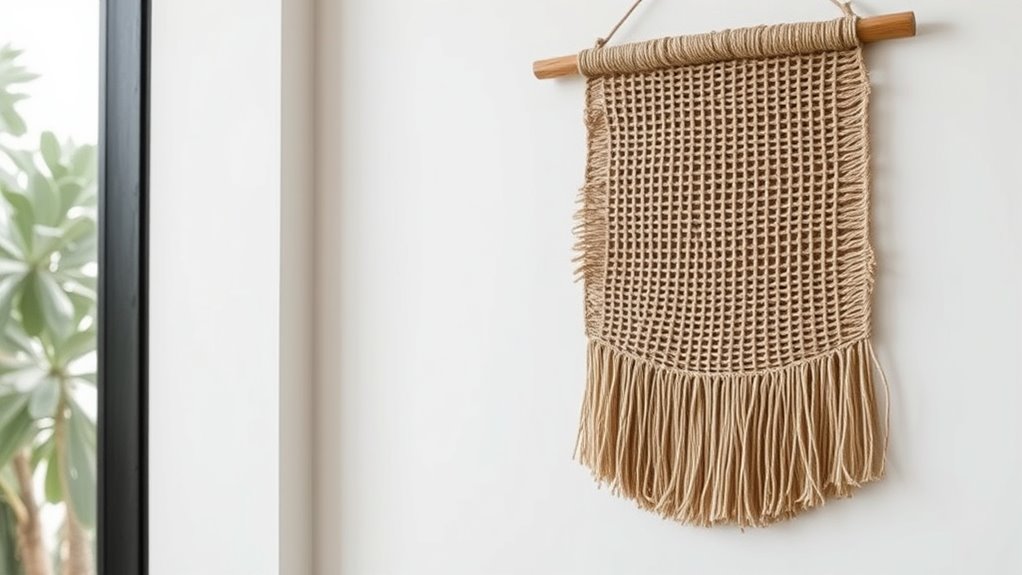
Adding texture to your minimalist decor doesn’t have to be complicated; clever choices can make a subtle yet impactful difference. You can incorporate layered textiles like throws and cushions to add depth without clutter. Textured wall art, such as carved wood or woven pieces, instantly creates visual interest while maintaining simplicity. Experiment with different materials and patterns to keep the space engaging. Use the table below for quick ideas:
| Decor Element | Creative Tip |
|---|---|
| Layered textiles | Mix soft and rough fabrics for tactile contrast |
| Textured wall art | Opt for sculptural or woven designs |
| Rugs | Choose textured or patterned rugs for grounding |
| Sculptural objects | Incorporate tactile sculptures or ceramics |
| Window treatments | Use fabric with subtle textures or embroidery |
These strategies keep your space minimal yet rich in tactile detail, aligning with the principles of minimalism and creating a more inviting atmosphere.
The Impact of Texture on Visual and Sensory Experience
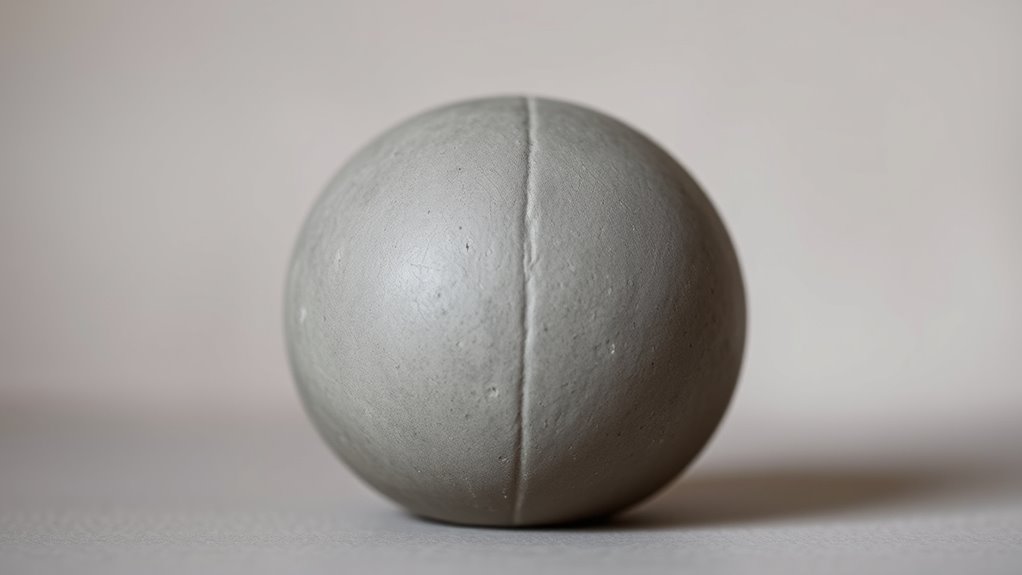
Incorporating texture into your minimalist space does more than enhance aesthetics—it profoundly influences how you perceive and experience the environment. Texture engages your senses, transforming a simple visual scene into a rich, tactile experience. When you add textured elements, your sensory perception deepens, making the space feel more inviting and alive. Tactile engagement sparks emotional responses, creating a sense of comfort and connection. You might feel a calming softness under your fingertips or the invigorating roughness that energizes a room. These textures evoke feelings of warmth, tranquility, or even nostalgia. By thoughtfully integrating texture, you craft an environment that stimulates your senses, fostering a more meaningful, immersive experience in your minimalist space. Incorporating sustainable design principles can also enhance the tactile experience while supporting environmental well-being.
Tips for Achieving a Cohesive Textured Minimalist Look

To create a cohesive textured minimalist look, focus on balancing different tactile elements so they complement rather than compete with each other. Start by choosing a restrained color palette—stick to neutral tones or soft hues—to unify varied textures and keep the space calm. When selecting furniture, pay attention to proportions; opt for clean-lined pieces with simple forms that don’t overwhelm the textures. Mix materials like smooth wood, rough linen, or soft wool, but guarantee they harmonize within your chosen color scheme. Avoid cluttering the space with too many contrasting textures; instead, let a few key tactile elements stand out. Incorporating texture in minimalism can enhance visual interest without disrupting the clean aesthetic. Consistency in color and proportion helps create a seamless, inviting environment where textures add depth without disrupting the minimalist aesthetic.
Frequently Asked Questions
How Does Texture Influence the Perceived Size of a Minimalist Space?
Texture substantially influences the perceived size of your minimalist space by adding visual weight and depth. When you use tactile textures, such as rough or layered surfaces, they create a sense of richness that can make the space feel larger and more inviting. Conversely, smooth textures tend to emphasize openness and simplicity, making the room appear more spacious. Your choice of texture shapes the overall spatial perception, balancing minimalism with tactile interest.
Can Textured Elements Make a Minimalist Room Feel Cluttered?
Yes, textured elements can make a minimalist room feel cluttered if not used carefully. They disrupt visual balance by adding complexity, but when you choose textures that create tactile harmony, they add depth without overwhelming. Focus on sparingly incorporating textured pieces that complement your space’s simplicity. This way, you maintain a clean look while enriching the tactile experience, making your minimalist room feel inviting rather than chaotic.
What Are the Best Low-Maintenance Textured Materials for Minimalism?
Think of natural fibers and matte finishes as your minimalist’s silent partners. They bring tactile warmth without demanding attention. You’ll find that linen, jute, and hemp require minimal upkeep, offering subtle texture that feels inviting. Matte finishes on wood or ceramics add depth without glare or fuss. These materials symbolize understated elegance, making your space feel thoughtfully curated yet effortless to maintain. They’re perfect for a tactile, low-maintenance minimalist aesthetic.
How Can I Introduce Texture Without Disrupting the Minimalist Color Palette?
You can introduce texture without disrupting your minimalist palette by contrasting tactile elements with sleek surfaces. Use materials like linen, wool, or textured ceramics for accessories or upholstery, adding depth without overwhelming the space. Keep the color palette simple and neutral, letting the different textures stand out. This balance enhances tactile interest while maintaining the clean, minimalist aesthetic, creating a subtle yet engaging environment.
Are There Specific Textures That Work Better in Small Minimalist Apartments?
Did you know that 78% of small apartments feel more inviting with intentional texture? You should consider using natural materials like linen, wool, or rattan to add textural contrast and tactile comfort without overwhelming your space. These textures create visual interest while maintaining a minimalist aesthetic. Opt for a chunky knit throw, a woven rug, or textured cushions to enhance your small apartment’s warmth and personality seamlessly.
Conclusion
By thoughtfully adding textures, you turn a simple space into a sensory haven. Think of it as painting with tactile brushstrokes—each element adding depth without clutter. Embrace natural materials, soft fabrics, and subtle patterns to create warmth and interest. Remember, less truly is more; your minimalist sanctuary becomes a cozy retreat, much like a well-worn leather armchair in a quiet library—inviting, rich, and beautifully textured.

